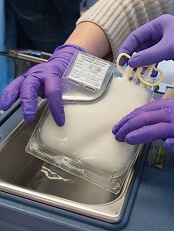Doc provides perspective on CAR T-cell therapy in CLL

Photo from Penn Medicine
NEW YORK—Trial data on the use of chimeric antigen receptor (CAR) T cells in chronic lymphocytic leukemia (CLL) are maturing, and a speaker at Lymphoma & Myeloma 2016 provided some perspective on the therapy as it now stands.
Stephen J. Schuster, MD, of the University of Pennsylvania in Philadelphia, noted that some CLL patients treated with CAR T cells remain in complete remission (CR) for more than 5 years.
Therefore, CAR T cells may be a consideration for patients who are resistant to chemotherapy.
“[I]mportantly, this immunologic approach, like other immunologic approaches . . ., tends to be non-cross-resistant to chemotherapy,” Dr Schuster said.
He made these and other observations while discussing trials of CAR T-cell therapy (particularly CTL019) in CLL.
Pilot study of CTL019 in CLL
CTL019, which is the CAR T-cell therapy used by investigators at the University of Pennsylvania, is licensed to Novartis.
The pilot study of CTL019, begun in 2009, enrolled 14 patients who had failed at least 2 prior therapies and progressed within 2 years of their last treatment.
Four patients (29%) achieved a CR, and 4 (29%) achieved a partial response (PR), for an overall response rate of 57%. Detailed results from this trial were reported earlier in HematologyTimes.
Two patients in this trial are still in CR beyond 5 years.
When investigators analyzed the different variables that might affect response—including age, number of prior therapies, p53 status, CAR T-cell dose, and the presence of cytokine release syndrome (CRS)—2 things became apparent.
First, patients who responded tended to have greater in vivo expansion of the CAR T cells than non-responders. And second, the responders had a greater incidence of CRS than non-responders.
Additionally, complete responders were negative for minimal residual disease (MRD) and had durable responses.
“This actually is different from the data you see in lymphoma with CAR cells,” Dr Schuster said. “[However,] it’s what we see in ALL [acute lymphoblastic leukemia] as well.”
Investigators also discovered that persistence of CAR T cells correlates with B-cell aplasia. In this trial, persistence of CAR T cells and B-cell aplasia were apparent at 12 and 18 months, and, in some cases, even longer.
“This is in distinction to what we are observing in trials with the lymphomas,” Dr Schuster said. “So what’s going to emerge is that the different diseases will have different response rates, different degrees of persistence of CAR cells and different toxicities.”
“When we compare B-cell ALL, B-cell non-Hodgkin lymphomas, you’ll get different responses across the subtypes of lymphomas, some unique toxicities, and differences in CLL. So these are all different diseases.”
Dose-finding trial of CTL019 in CLL
The second trial of CTL019 in relapsed/refractory CLL patients was a dose-finding study. Updated results from this study were presented at ASCO 2016.
The high-dose arm (5x108 CTL019) had a 10 times higher dose of CAR T cells than the low-dose arm (5x107 CTL019).
Investigators treated 12 patients in each arm in the first phase of the study, and then expanded the trial to include another 8 patients at the recommended dose. The phase 2 trial was powered for response rates but not duration of response.
Twenty-eight patients were enrolled, with 24 evaluable, 11 in the high-dose arm and 13 in the low-dose arm.
Their median age was 62 (range, 51-75), the median number of prior therapies was 4 (range, 2–7), 38% had p53 deletion, and 12% had received prior ibrutinib therapy.






